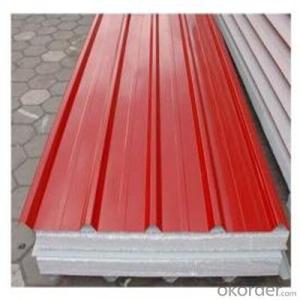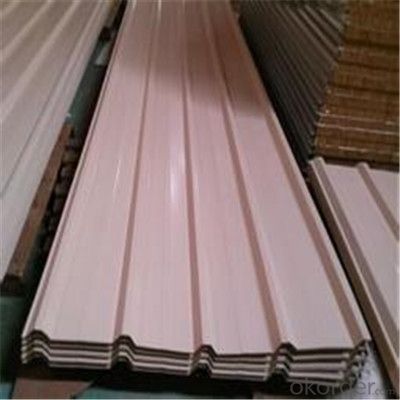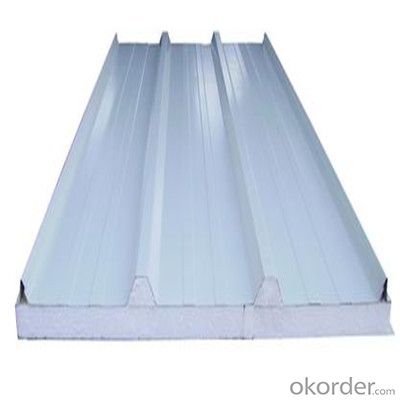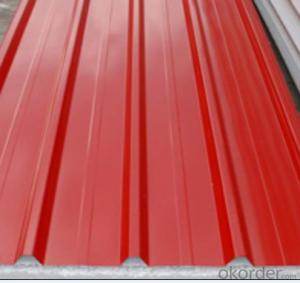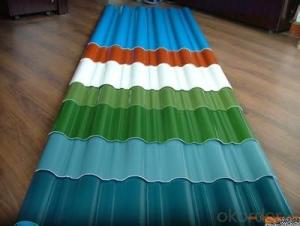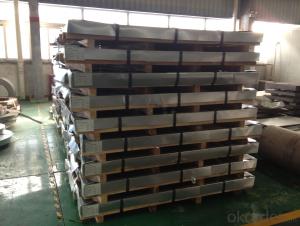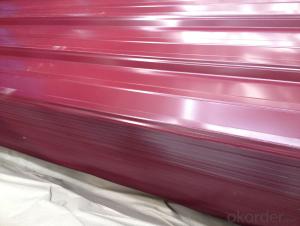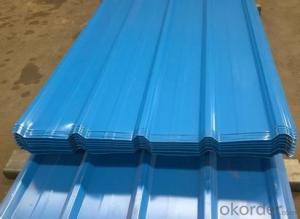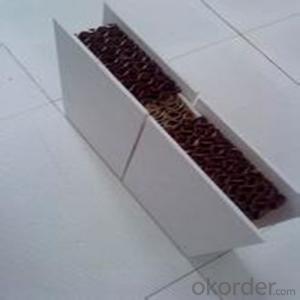Color Coated Galvanized Corrugated Iron Sheet
- Loading Port:
- Shanghai
- Payment Terms:
- TT OR LC
- Min Order Qty:
- 50 m.t.
- Supply Capability:
- 1000000 m.t./month
OKorder Service Pledge
OKorder Financial Service
You Might Also Like
Specification
Description of Corrugated Iron Sheet:
Thickness: 0.14-3.0mm
Zinc Quantity: 60-350g/m2
Inner Dia: 508mm or 610mm
Surface Treatment: Regular Spangle, Minimized Spangle, Zero Spangle, Bright Spangle
Coil Weight: usually 3-5MT for export(or according to customer request)
Packing: standard sea worthy export packing
Delivery time: 10-15days after receiving your deposit or workable L/C
Place of Origin: Tianjin, China
Specifications of Corrugated Iron Sheet:
Standards: GB, JIS3312 and ASTM
Materials: SGCC, Q195-Q235B, SPCC, DC01, DX51D+Z and more
Thicknesses: 0.23-1.0MM
Widths: 600-1200mm
Zinc coating: 80 to 275g/m²
Features of Corrugated Iron Sheet:
1. Packing: Export sea worthy package
2. Delivery time: Within 30days after receiving 30%T/T of deposit or L/C
3. Application:prepainted corrugated steel coil applies to Structural use ,roofing, commercial use, household appliance, industry, family etc
4. Quality control:
a)Mill Test Certificate is supplied with shipment.
b)Third party inspection is highly welcomed.
Images of Corrugated Iron Sheet:
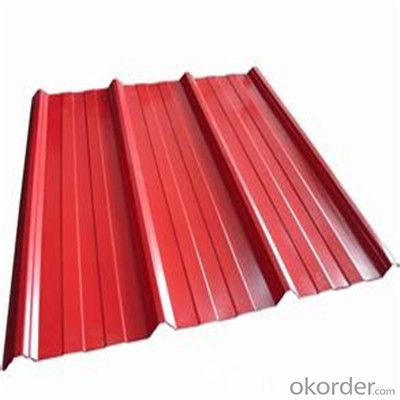
FAQ:
1. What's the Delivery port?
The main ports are Qingdao and Tianjin, we also can deliver to other ports to meet your requirements
2. How long is the lead time?
Delivery time: 45 days after order confirmed.
3. What payment term do you accept?
Payment: T/T or L/C at sight.
- Q: What are the different surface textures for pre-painted steel sheets?
- There are several different surface textures for pre-painted steel sheets, including smooth, matte, textured, embossed, and patterned.
- Q: Can steel sheets be used in corrosive environments?
- Corrosive environments necessitate careful consideration of the type of steel used and appropriate protective measures. Stainless steel, for instance, is known for its exceptional resistance to corrosion and ability to withstand harsh conditions. It contains chromium, which creates a protective oxide layer on the surface, preventing corrosion. Alternatively, galvanized steel involves applying a layer of zinc to the surface, forming a protective barrier against corrosion. Furthermore, one can enhance the resistance of steel sheets to corrosive elements by applying various coatings like epoxy, polyurethane, or paint. The selection of the right steel grade and protective coatings is crucial and should be based on the specific corrosive environment to ensure long-lasting performance. Regular inspections and maintenance are also imperative to promptly identify and address any potential signs of corrosion.
- Q: How do you repair damaged steel sheets?
- To repair damaged steel sheets, the process typically involves identifying the extent of the damage, cleaning the affected area, and then either welding or patching the damaged section. Welding is commonly used for minor damages, while patching with epoxy or steel patches is suitable for more significant damage. Additionally, proper surface preparation, such as sanding or grinding, is crucial before applying any repair method to ensure a successful and durable repair of the steel sheets.
- Q: Can steel sheets be used for interior design purposes?
- Yes, steel sheets can be used for interior design purposes. Steel sheets have a sleek and modern appearance that can add an industrial or contemporary touch to any interior space. They are durable, long-lasting, and resistant to wear and tear, making them suitable for high-traffic areas. Steel sheets can be used in various ways in interior design, such as wall cladding, ceiling panels, room dividers, furniture, countertops, and backsplashes. They can be painted or coated in different finishes to match the desired aesthetic, and can also be shaped or perforated to create unique patterns or textures. Overall, steel sheets offer versatility, strength, and a visually appealing element to interior design projects.
- Q: What are the weight considerations for steel sheets?
- Weight considerations for steel sheets vary depending on the specific application and desired outcomes. Here are a few key points to consider: 1. Thickness: The thickness of a steel sheet greatly affects its weight. Thicker sheets generally weigh more, while thinner sheets weigh less. It is important to choose a thickness that meets the structural requirements of the project while considering weight limitations. 2. Strength requirements: Different applications require steel sheets of varying strength levels. High-strength steel sheets are often thicker and heavier, while lower strength sheets can be thinner and lighter. Understanding the strength requirements of the project is crucial in determining the appropriate weight of the steel sheets. 3. Transportation and handling: The weight of steel sheets impacts their ease of transportation and handling. Heavier sheets require more labor and equipment for lifting, loading, and unloading. Moreover, transport vehicles have weight limits that need to be considered when selecting steel sheet sizes. 4. Structural limitations: The weight of steel sheets can affect the overall structural design. In some cases, lighter sheets may be preferred to reduce the load on supporting structures. However, in other scenarios, heavier sheets may be necessary to provide the required strength and stability. 5. Cost considerations: The weight of steel sheets can also impact the overall cost of a project. Heavier sheets typically cost more due to the increased material required and the additional handling expenses. Therefore, it is essential to strike a balance between weight, cost, and performance to optimize the project's budget. Overall, weight considerations for steel sheets are crucial in determining the appropriate thickness, strength, transportation requirements, structural design, and cost-effectiveness of a project. By carefully evaluating these factors, one can select steel sheets that meet the specific needs while ensuring the optimal weight for the desired outcome.
- Q: Are steel sheets suitable for harsh weather conditions?
- Steel sheets are highly suitable for harsh weather conditions due to their durability and strength. Steel is renowned for its ability to withstand extreme weather conditions, including high winds, heavy rain, snow, and hail. Moreover, steel sheets are designed to resist corrosion, rust, and degradation caused by prolonged exposure to severe weather, ensuring their longevity and dependability in any climate. Furthermore, steel sheets can be coated with protective finishes, such as galvanized or painted coatings, which further enhance their resistance to weathering. This aspect has made steel sheets a popular choice for various applications in areas prone to harsh weather, such as roofing, siding, and outdoor structures. They provide exceptional protection and structural integrity even in the most challenging weather conditions.
- Q: What are the different types of steel sheet coatings?
- There are several different types of steel sheet coatings, including galvanized coatings, tin coatings, and polymer coatings.
- Q: Can steel sheets be used for bridge construction?
- Yes, steel sheets can be used for bridge construction. Steel is a commonly used material in bridge building due to its strength, durability, and resistance to corrosion. Steel sheets are often used to fabricate the structural components of bridges, such as beams, girders, and decks, providing stability and reliability to the overall structure.
- Q: How are steel sheets coated for corrosion resistance?
- Steel sheets are typically coated for corrosion resistance through various methods such as hot-dip galvanizing, electroplating, or applying organic coatings like paints or powder coatings.
- Q: How are steel sheets measured and sized?
- Steel sheets are commonly measured and sized based on their thickness, width, and length. Thickness is usually measured in gauge or millimeters, while width and length are measured in inches or millimeters. The size and dimensions of steel sheets can vary depending on the specific requirements of a project or application.
Send your message to us
Color Coated Galvanized Corrugated Iron Sheet
- Loading Port:
- Shanghai
- Payment Terms:
- TT OR LC
- Min Order Qty:
- 50 m.t.
- Supply Capability:
- 1000000 m.t./month
OKorder Service Pledge
OKorder Financial Service
Similar products
Hot products
Hot Searches
Related keywords


